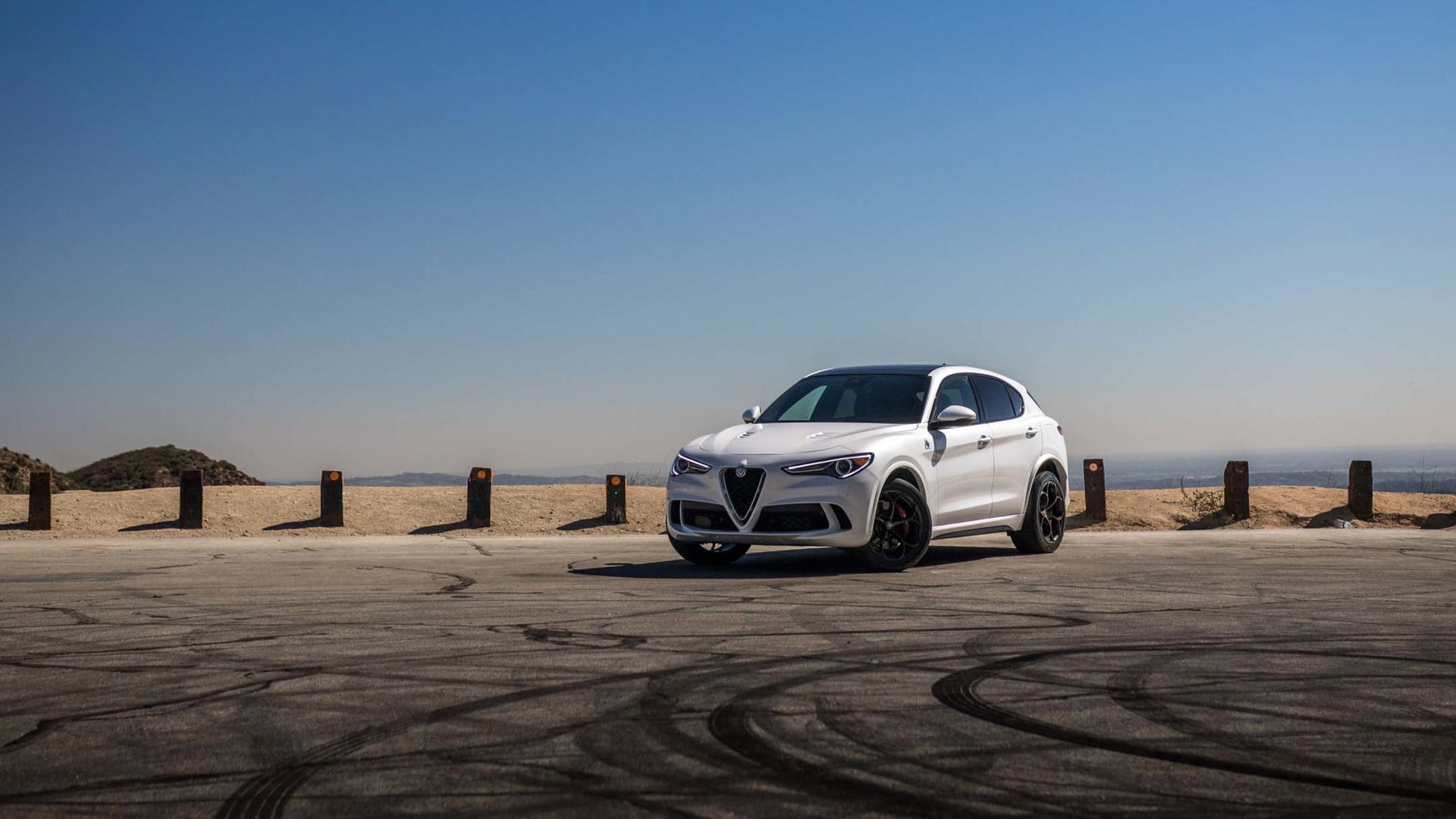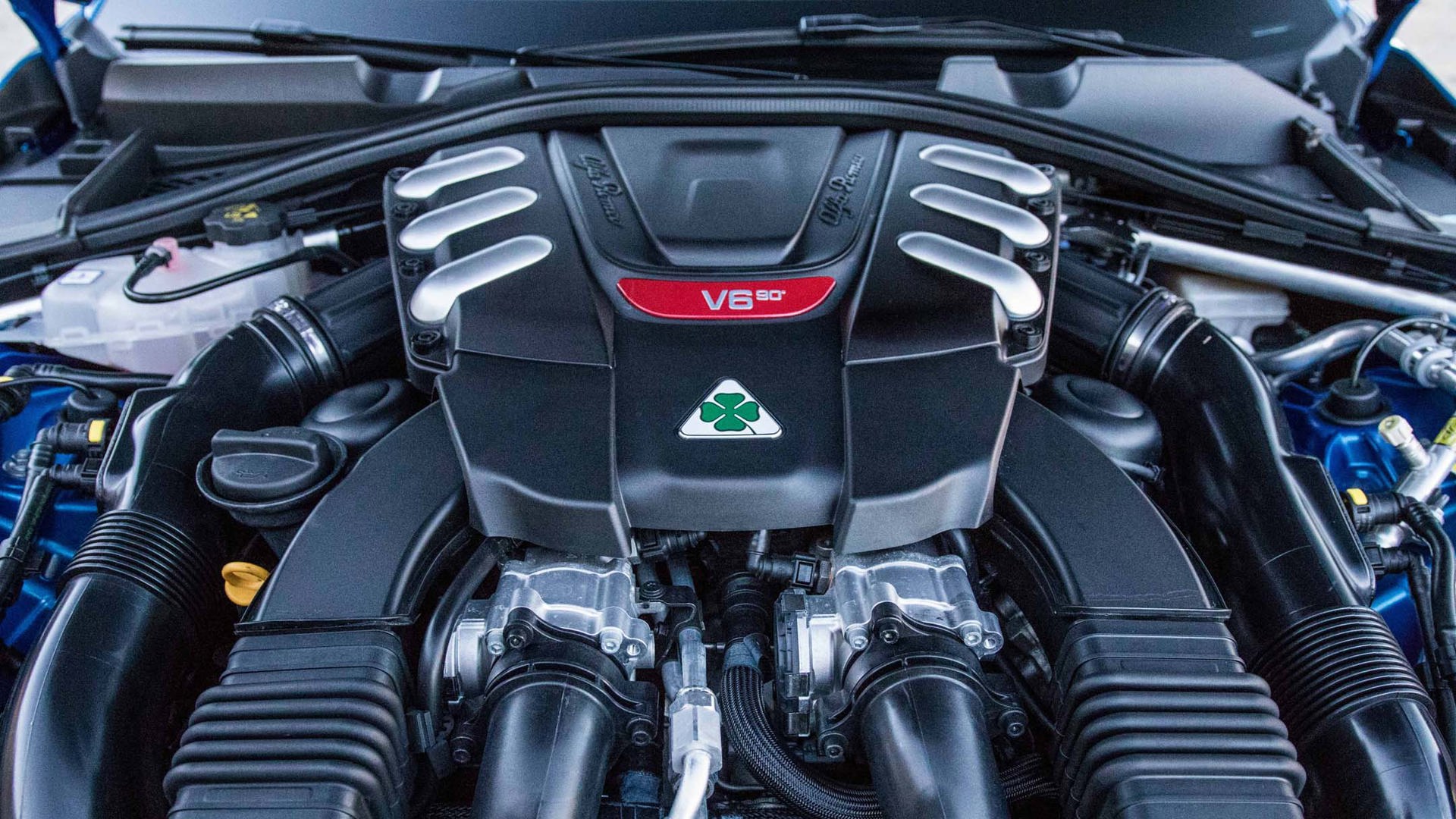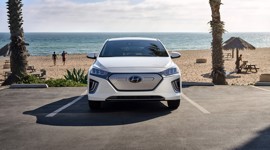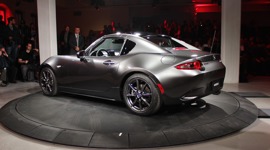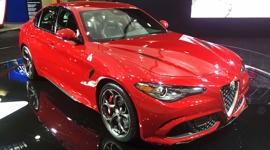There are essentially two types of famous Italian-Americans: Mario Andretti and Chef Boyardee. (Also, I suppose, a footnote to the denizens of the Legitimate Businessman’s Social Club of Springfield.) With the former, old-world passions blend with western open-heartedness to produce a charming and heroic champion. With the latter, things are suitably dumbed down for mass consumption.
So, which Italian-American is the reborn, Fiat-Chrysler-owned Alfa Romeo? Certainly the brand has a depth of history to mine, with a near-century history of epic motorsports achievements. Alfa Romeo gave Enzo Ferrari his life’s work. At the German Grand Prix in 1935, it was an Alfa Romeo P3 Tipo B that gave the Nazis’ state-funded racing team an embarrassing thrashing in front of Hitler himself. Alfas won hill climbs and rallies and the hearts of nearly everyone who drove them. They became part of our popular culture, appearing in films like The Graduate. At this year’s Pebble Beach concours, an Alfa Romeo (restored by a bunch of Canadians) was judged the most elegant car from a field of the world’s best.
Which brings us to the traffic-clogged streets of Los Angeles, a city built on the illusion that car ownership equals freedom. It’s possible to live in Los Angeles without owning a car, but only if you own a motorcycle. This is a city on wheels, and during peak traffic times, those wheels aren’t rolling.
The established luxury marques, even performance-oriented brands like Porsche and Lamborghini, have long ago recognized that corner-carving image doesn’t dovetail with reality. They build vehicles with huge wheels and brakes but are also careful to engineer in compliant rides that don’t jostle their occupants, focussing development where the sales are: in high-riding crossovers with tech-filled interiors.

The charm of an old Alfa Romeo has little to do with the sort of daily grunt work done by most automobiles. They’re all about the smell of leather, wood, oil – and overflowing coolant. The best road-going Alfa Romeos of the past were built for cool and lonely mornings in the hills. Most of them feel like they missed the day in kindergarten where the concept of sharing was explained.
Yet here we are just a few miles from the perpetual construction surrounding LAX, up to our wing mirrors in a vehicle that hopes to blend the solitary charms of the past with the uncomfortably crowded reality of the present. Alfa couldn’t have named this crossover any better: the Stelvio is so-dubbed for a high pass in the Italian Alps, one made famous by an episode of Top Gear. It contains more loops than an elephant’s intestines, and is reportedly a joy to drive when it’s not crowded with tourists coming to gawk at one of the best driving roads... “in the world.”

We are not in the Italian Alps. In fact, I’m not sure you could even get a half-decent fettuccine Alfredo around here. LA is flat, hot, busy, and brownishly grubby around the edges, like a sun-bleached photograph plucked from the gutter. On the broken pavement, the Stelvio’s suspension chatters away with the irritation of a Sicilian grandmother whose favourite plate you’ve just dropped.
On the exterior, the Stelvio is a pretty handsome machine, a bit like a small Jeep Grand Cherokee. Things are much less convincing on the inside, which leans on affectations like a steering-wheel-mounted starter button, carbon-fibre trim, column-mounted shifter paddles the size of aluminum bananas, and bordello-red trimming. Take a look at the steering wheel, which is Alcantara up top, leather on the sides, and carbon-fibre on the bottom. Alfa’s throwing everything in here in a sort of high-performance tiramisu.

It’s the same story with the Giuila sedan, and both suffer when you look past the loud accents to the less convincing details. There’s a lot of ordinary plastic in here, and the infotainment system is very small, very slow, and not particularly high resolution. The seats grip as much as you’d hope they would, but there’s nothing in the interior that points to any particular artistry.
It’s not that either is unpleasant to drive in traffic, more that traffic itself is unpleasant and neither the Giulia nor the Stelvio do much to assuage that unpleasantness. The brakes are far too touchy, turning stop-and-go into a neck-snapping performance (and not in the good way). The steering is frantically quick. The suspension in both vehicles is harsh even in its softest setting. And given time to look around the cabin when stopping three times for a single traffic light, the driver is forced to notice an interior that’s not quite luxury-grade.

Yet even in Los Angeles, there’s an end to the traffic. Turning off the highway, we find ourselves at the foot of the Angeles Crest Highway, a greying piece of ribbony tarmac that slithers up into the mountains, before splitting, hydra-like, into some of the best roads in the world.
If you’re an Angeleno, and you’re into cars, you talk in canyons. People here still plan out early-morning runs into the hills, convoys of quick-moving machinery coursing through the dry and empty forest. Some canyon roads are closely guarded secrets, and some are well-known roller-coasters, but all provide the sort of place needed for an Alfa Romeo to finally come alive.

The Stelvio didn’t charm as a city slicker, but it’s a different story as the first tight left-hand corner comes into view. Touchy brakes which were a chauffeur’s nightmare become a driver’s delight, providing endless stopping power. The twin-turbocharged 2.9L V6 huffs out its 505 hp with whooshes and gurgles and hissing to match the man-eating snake it carries on its badge.
BMW and Mercedes have had the luxury of incremental evolution, engineering done in a methodical and plodding manner. Alfa Romeo seems to have spent all morning drinking espresso, and has designed a drivetrain that only does one thing well: attack!

The grip from the Pirellis is ferocious, but the slightly staggered setup means that you can push until the front tires just start protesting, then dial it back a little. The Stelvio’s pace up the crest is nothing short of staggering, with the all-wheeldrive system allowing the power to be poured on early. The more you push it, the more the Stelvio responds, its frantic steering and surging engine free at last.
It’s not just the speed, it’s the lack of filter. Even the Porsche Macan feels like it was built first to provide an undemanding and pleasant driving experience, and then had physics-defying dynamics programmed into the software. The Stelvio feels like Alfa Romeo came at things from the other end, building a performance car first, and then essentially running out of time to housebreak it.

I step out of the Stelvio, nerves jangling, wildly grinning. Yet a crossover is supposed to be a dual-purpose vehicle, and this Alfa isn’t going to be a crowd pleaser. It’s worse to think that the power that corrupts in the Quadrifoglio version won’t be there in the lesser 2.0L turbocharged models, but some of the same hyperactive faults will be.
After a day spent hucking around loud but modestly powered Italians in the desert, morning dawns yolk-yellow and glorious. It’s this kind of weather, day after day, that gets Californians up early to eat their granola, do a little yoga, work on mind-body-and-spirit, or maybe just go tear the face off a mountain pass.
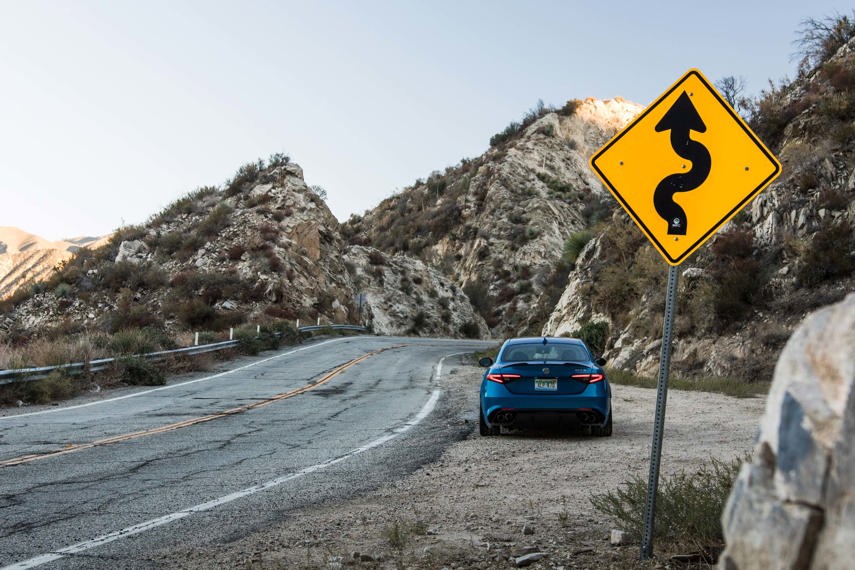
At 200 kg lighter than the Stelvio and rear-drive only, the Giuila Quadifoglio is even more ill-tempered. Both vehicles have the same quick steering, brake-by-wire system, and eight-speed automatic. As the Giulia was first to the table, everything about it seems earlier, rawer, less well-tamed. Which, when the road ahead of you is filled with signs like “Slide Zone,” makes you shout with internal glee. Andiamo!
Perhaps it’s that a sport sedan can be forgiven for being a little one-dimensional, or perhaps it’s the way the Giuila periodically twitches its rump when powering out of corners, but this machine is even more intoxicating than the Stelvio. Absent the Stelvio’s all-wheel drive, a little more patience on the throttle is required, but the car responds with just as much speed and power, and has a lighter, livelier feel to it.

The Giulia doesn’t stomp through a series of corners the way the German machinery does, nor does it flow with elegance. This is 505 hp we’re dealing with here, out of an engine that feels like it still carries a whiff or two of Ferrari F40 about it. That’s a high comparison to make, but the Giuila is sufficiently fast to eat nearly anything built by Maranello from more than a couple of decades ago, and even though it has four doors and a (cramped) rear seat, it has some of that same ferocious charm that you used to only get with a prancing stallion on the hood.
This is the one, I’m thinking to myself, that you would be willing to compromise your daily comfort for. Happy memories of a Sunday spent chasing supercars through the hills would go a long way to plaster over minor annoyances through the week. Perhaps the Giulia’s constant twitchiness, which never dials back even with the three-mode drive controller, would be a reminder of adrenaline-fuelled mornings, rather than mere irritation.

It’s around about this time that the passenger-seat power adjustment fails.
That behaviour, too, is part of Alfa heritage. The cars are great when they work, but hey, it’s when they work. Odds are you won’t just have to put up with fidgety dynamics, but with more trips to the service centre than you’d like. Hopefully the dealership at least offers Italian coffee.
I met Mario Andretti once, at the Indy 500 a couple of years ago. It was strange to shake hands with the legend and find that the man was almost entirely without pretension or arrogance. Mario was warm, and funny, and just as capable of making you feel like your questions were important as he was at careening into a concrete-lined turn at above two hundred miles an hour.

I’ve also had a can of Chef Boyardee or two in my time. I stopped liking it when I was a kid.
Modern Alfa Romeo is neither. It has not been made blandly appealing for your comfort. Nor has it been polished to the degree that would grant it lasting and legendary status. It’s something else: a little haughty, a little high-strung, wonderful when everything lines up, annoying when it doesn’t.
In short, Alfa Romeo isn’t Americanized at all, it’s remains essentially Italian. That may not be a formula for mass appeal, but in a time of ever-greater homogeneity across the automotive world, it is perhaps a recipe we can respect, capisce?





